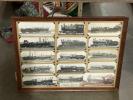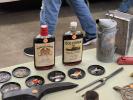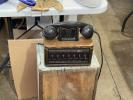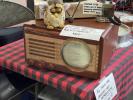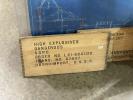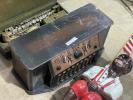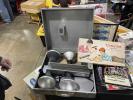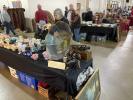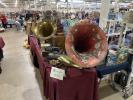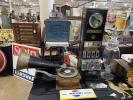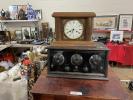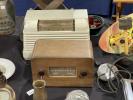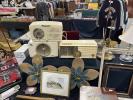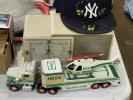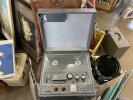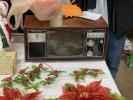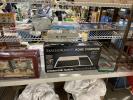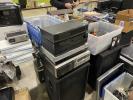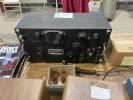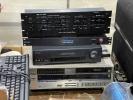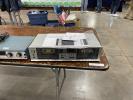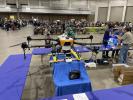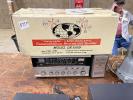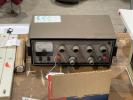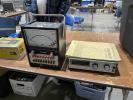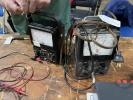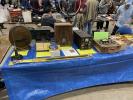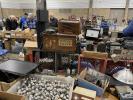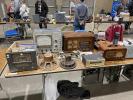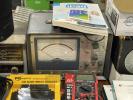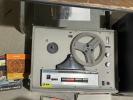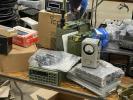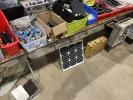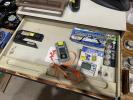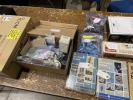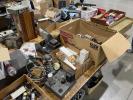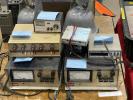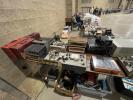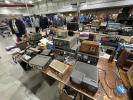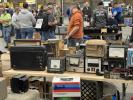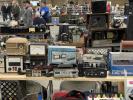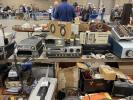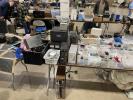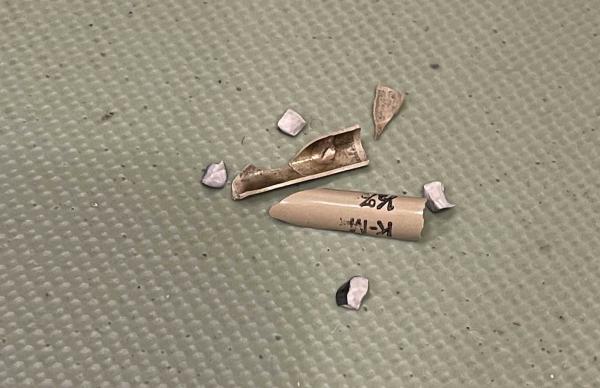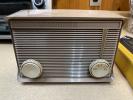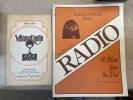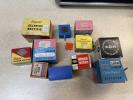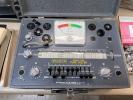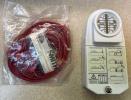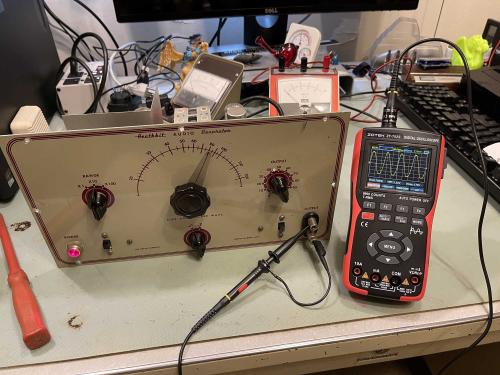- 2023
- Nov
- 29
Pictures from the November 2023 Scott Antique Market
This show takes place monthly at the Ohio Expo Center (State Fairgrounds) and runs from November to April. There’s generally not a lot of electrical goods here, but this time I was surprised. A lot of radios and other technology related goodies showed up. I suspect this is in part due to the show being the first one of the season, and being close to the holidays - everyone is looking for that perfect gift.
While not all of the pictures I took were of electrical things, I found the stuff to be interesting (or strange!) enough to take a picture of. I’ll probably hit next month’s show as well, so stay tuned!
- 2023
- Nov
- 29
Pictures from the Fort Wayne Hamfest 2023
This year’s show seemed to be a bit smaller than normal, but it may have been just my imagination. Regardless, there was a lot to see and the show was, as usual, busy. I tried to limit what I brought home to things that were on my want list, and I mostly did so - only diverging for a book that looked interesting. I’ve written about one of the pieces, a meter from Heathkit, so check out the posts just previous to this one for a look at that piece.
- 2023
- Nov
- 26
A Heathkit IM-1212 from the Fort Wayne Hamfest - making it work again.
One of the things I picked up at the Fort Wayne hamfest was a Heathkit IM-1212 NIXIE DVM. This device was sold as a kit, and was also known as the Bell & Howell IMD 202-2, as well as a DeVry branded unit. They were all the same, with different branding on the front panel.
The device itself is a 2 1/2 digit meter, and uses discrete components - all ICs are common TTL stuff - to do it’s work. It’s not the most accurate thing in the world, but I imagine it was designed to help you learn about A/D conversion and other concepts while giving you a device that you could (mostly) use at the end.
This unit was sold as working, which I verified with a 120VAC inverter/battery pack from the tool company in the harbor. I offered the guy a $20 for it, which he accepted and I took my purchase home.
It’s not in bad shape for the age, a bit of discoloration on the front panel and the obligatory tape residue on the top of the device.
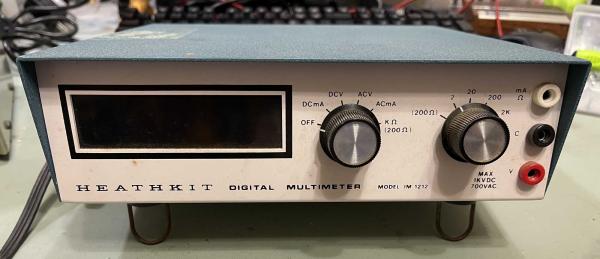
It came with the original instruction manual, which is useful for troubleshooting any issues.

All of the tubes are nice and bright like it doesn’t have many hours on it. Even the NE-211 bulbs that are normally shot don’t exhibit any flickering or problems ionizing.
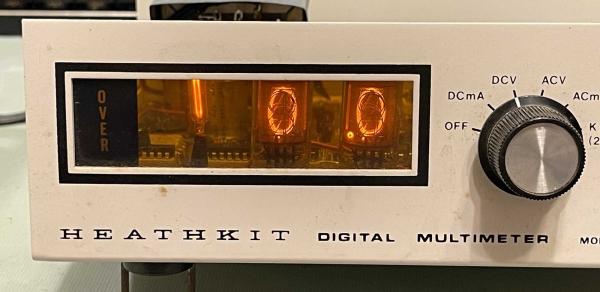
I did notice a few issues, there’s a rattle inside. Something is broken. The negative jack is also loose, which is probably just a nut come loose. The device also doesn’t respond to any input - something to do with the loose negative jack, perhaps?
Time to open the top cover. Notice the line of big beige resistors on the left and the one blue specimen at the bottom? These are calibration resistors, and one had apparently broken at some point, as the rattle was the remains of an old part. The original owner hadn’t removed the debris for some reason.
You’ll also notice there’s a number written on the paper cover. This is the DC calibration voltage as provided by Heath. It’s wrong, so ignore it and get a good 3 2/3 digit meter and measure the DC cal point. Mine turned out to be 1.901, so I used that later during calibration.
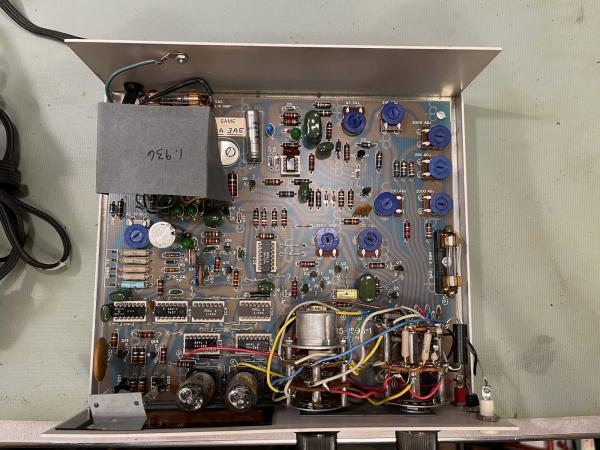
I discarded the broken pieces and looked at the negative jack. Sure enough, the nut was backed off, and that was because the cheap plastic threads on the jack were worn. While it tightened up, one more turn would knock it back. That will have to be replaced if I want to put this into service, but I think where it’s going it will be connected and let set as a monitor device.
The loose jack was also the cause of the no reading issue. The loose jack and solid wire insured the wire itself broke. That was an easy fix, just a quick re-solder and we’re back in business.
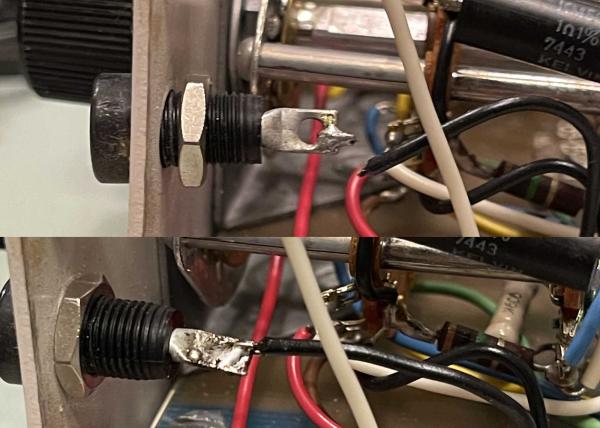
Time to hook it up to a power supply and see what it reads. It’s close, I guess for something of unknown quality it’s fine. As I stated earlier, these weren’t known for being the most accurate of devices, nor were they known for staying where you put them. Fortunately, the DC calibration is pretty easy, just requiring the device having been on for some time to temperature stabilize.

I’ve already posted the DC calibration procedure for someone, so if you haven’t read it you can do so here: https://wereboar.com … t-im-1212-nixie-dvm/
I don’t think there’s much more to say about this device that hasn’t been said already by many others. I’m planning on making a small board that switches between the different voltages in my network rack, so that may show up at some point. Until then, stay tuned for pictures from Fort Wayne and the Scott Antique Market at the Ohio Expo.
- 2023
- Nov
- 23
DC Calibration of the Heathkit IM-1212 NIXIE DVM
The Heathkit IM-1212 DVM is a 2 1/2 digit multimeter sold by Heathkit (obviously!) as well as under the Bell&Howell name as the IMD 202-2. They are the same unit with a different name on the front. I’ve also been told that DeVry had one marked with their name as well, but I’ve not seen one of those.
(Hi hobbyshoppin…will copy the actual relevant portions of the manual for you next week!)
These are not the most accurate meters, and are hard to keep in cal. DC calibration is fortunately, fairly easy.
We’re interested in 4 spots in this meter, indicated by the red outlines in the image. They are, from left to right:
1: The DC CAL test point.
2: The OSC adjustment.
3: The ZERO adjustment.
4: The DC CAL adjustment.
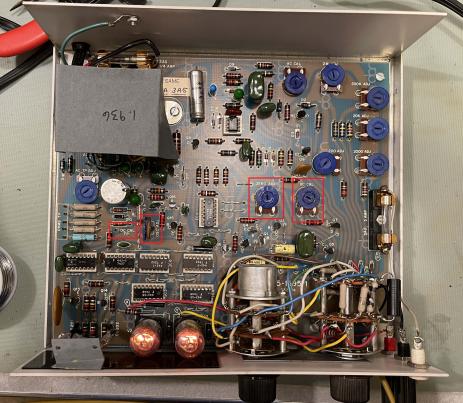
(click on the image to enlarge)
What you’ll need:
A small flatblade screwdriver to turn pots. A plastic alignment tool will work best if you have it.
A meter with at least 3 1/2 digits of accuracy
A cliplead
Start by removing the screws for the cover. Look inside and make sure nothing looks burnt or damaged. If you’re good, put the cover back on, and apply power to the unit. Turn it on, and set it to DC Volts, “2” range.
Let it set with power on. The manual suggests 15-30 minutes warmup time, but I say give it a few days. You want this thing to be as warm as it’s going to get. Just let it set. It needs to be nice and temperature stable.
When it’s warmed up, remove the top cover. Start by looking at the paper on the transformer. There’s probably a number written there. Ignore it. That’s the DC CAL voltage as suggested by Heath. It’s wrong.
With your negative lead on the black jack on the front (all measurements are in reference to this jack) measure the DC voltage on the DC CAL test point. It should be 1.9xx-ish. It may be 2.xxx or 1.8xx, but note that to 3 digits. For example, mine states 1.936V, but the actual measurement was 1.901V. Note your voltage somewhere for later use.
Note: This voltage is generated by two crappy carbon comp resistors, so it’s going to drift as well. If you have something with a known voltage around 1.9V, then use it instead!
Jumper the red and black jacks. Using the ZERO adjustment, turn it until you get to 0.01, and then turn it until it JUST goes to 0.00. Heath suggests that at this point, the reading should flicker between 0.00 and 0.01. I usually just set it to 0.00 and don’t worry about it.
This part isn’t in the manual. I don’t know if it will help, but it may get you closer to the specified oscillator value…
Change to KOHMS and open the top. Let it set for a while open circuit so you’re getting the oscillator number. When it’s stopped changing, note it. Put the cover back on and observe the drift. When it’s stopped drifting, note this value as well. When you have the top off to adjust the oscillator, adjust it so that you’re accounting for the drift - i.e. if it drifts up, set it X counts lower, etc.
Or, just do what the manual says and…
Remove the jumper and change the input to KOHMS. The OVER lamp should be lit at this point, you want an open circuit. Using the OSC adjustment, adjust so the display reads .85.
Change back to DC Volts. Connect the red jack to the DC CAL test point. Adjust the DC CAL adjustment so the meter reads as close to your measured voltage as possible. Round the number based on the last digit of your measured voltage. Round up for 6, down for 5.
At this point, you should be able to get a good DC measurement out of the device. Be aware that it’s not very accurate, and on the 20 range you’re going to have a +/- of 0.5V. You may want to go through and adjust things again later after the unit has warmed up more, but you’re never going to get a super accurate reading out of this device.
That’s it for DC. If you want to do the rest of the calibration, I’ve copied the relevant portions of the manual and placed them here:
- 2023
- Nov
- 21
Notes from the Fort Wayne Hamfest
Fort Wayne was pretty good this year, and I have a lot of pictures to process and upload.
In the meantime here’s a bit on a device I picked up. It’s a 2 1/3 digit DVM made by … I don’t know. I’ve seen it sold as Heathkit, Bell&Howell, and others. It’s not the most accurate thing in the world, but it was easy to put together and looks to be a good tool for teaching basic A/D concepts. It’s very drift-y, and from what I can tell was known to be such even when it was new. It’s still cool, however.
It required some minor work and adjustments to get it up and running, which I’ve documented and will post later - but in the meantime, here’s the device doing integrations on a low speed sine wave. It counts as fast as the TTL silicon will allow it.
(If the below gif doesn’t play, click on it.)
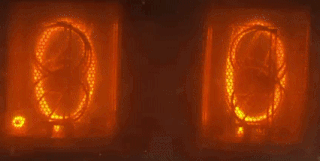
Stay tuned for more electronics junk good stuff!
- 2023
- Sep
- 22
Pictures from Findlay 2023
The Findlay Radio Club 2023 Hamfest was just a bit muted this year - the skies threatened rain but none appeared, so there were quite a few vendors. This year, a lot of late-model Hallicrafters SW radios showed up, I assume because people who purchased them in the 1960s are finally letting them go for various reasons. Unfortunately, with nothing to listen to on shortwave except Radio Havana, these radios aren’t of much use other than as a curiosity. The proliferation of SDR boxes hasn’t helped, considering you can get a direct entry radio that sounds good and runs on a common LiIon prismatic cell for a bill.
There was plenty of good stuff to look at regardless, and some good things to take home. Here’s my memories of the show, some of which were of unique pieces where the photo ended up on other sites.
One of those shots was a relatively rare signal generator from a long-dead company, Measurements Corporation of Boonton, NJ. According to the site admins, this was the only in-the-flesh image they’ve seen. I was happy to contribute to the community’s knowledge base. Check that entry out here: https://www.radiomus … rd_generator_82.html
Now, on to the good stuff!
- 2023
- Sep
- 14
Findlay 2023 has come and gone.
Rain threatened but didn’t invade this year, so there was a decent number of vendors and some good stuff to see. Pictures from the show are coming soon, I’m processing them and hope to have them up next week.
I find myself bringing home less and less each year, as I’ve already accumulated as many boat anchors as I can handle, and I didn’t see the few I’d like to acquire at the show. I limited myself to some meters, some oddball parts, and a few collectible items that looked interesting. Nothing really special, just neat.
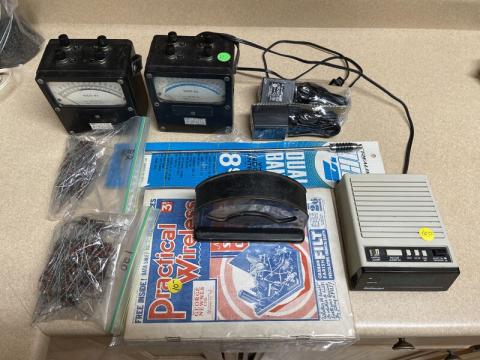
A couple of Weston meters, an antenna for a scanner, some carbon resistors, a weather radio clock, some wall warts that were 50 cents each, and a couple of old UK radio magazines. I’ll probably go back for more magazines, since that guy was local to my home area.
Stand by for the show pictures…
- 2023
- Sep
- 7
Neat things at the Johnstown Swapper’s Day 2023
I usually don’t take any photos at this event, because it’s just a general flea market - but things of interest do show up there from time to time. While these items aren’t all related to electronics, I still found them interesting enough to snap a shot.
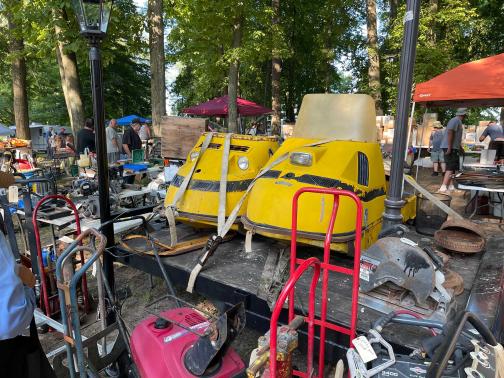
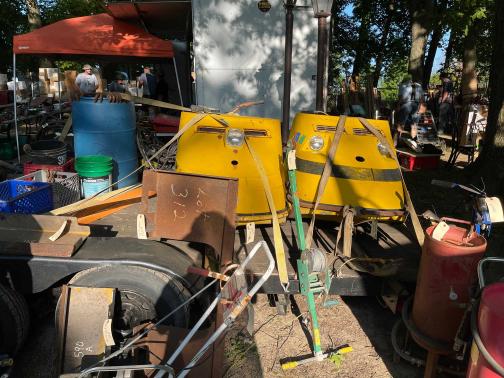
Someone found some a variety of late 1960s and early 1970s Skidoo snowmobiles and brought them for sale.
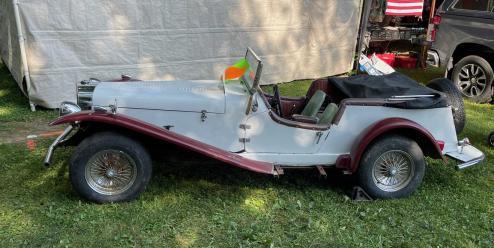
A “Mercedes Gazelle” built on a VW chassis. The Bug was a popular platform for modification and, at one point, you could make it look like just about anything you wanted.
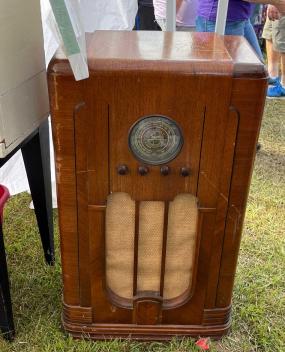
A nice Sparton 667 radio. Everything was present, and the chassis looked unmodified and clean. It had what appeared to be a number of gel electrolytics, so hopefully whomever brought this home doesn’t just plug it in.
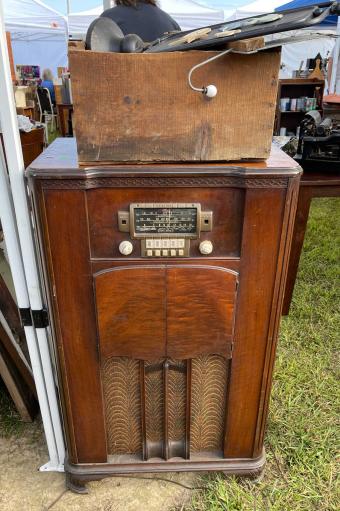
I didn’t get the model of this Zenith console, but the chassis was similarly clean and unmodified. The record player had been removed, however, but that’s not a terrible loss - chances are the stylus was long dead and unobtanium.
The rest of the trip was just your standard flea-market stuff, and I ended up going home with a small album of 78s and a few tools.
- 2023
- Aug
- 11
My haul from the Columbus 2023 Hamfest
I really tried to be good this year and not drag home much. Some parts and things still made it into my car, however - I guess I just didn’t lock the doors or something.
But, I did limit myself to something I’ve been looking for (An AA5 radio and a tube tester,) some books, and a handful of parts. The only real impulse buy was the Simpson Meter - how can you pass up that awesome Bell System aqua and yellow? While it’s not of much use these days, requiring oddball 15V batteries, it’s still an interesting piece and will go on display with my other Bell System artifacts.
I wanted to bring home the big coffin radio that was at the show, but there’s simply no room for that. Some other test equipment caught my eye as well, but again - no room or need. I don’t need a 200W meter sitting in the rack drawing more current than the rest of the equipment!
Everything that I could test works well, and I kept spending to a minimum. I guess that leaves more money for later shows(?) We’ll see what Findlay brings…
- 2023
- Aug
- 8
Checking out a Heathkit AG-7 Signal Generator
This is a Heathkit AG-7 audio signal generator. One of Heathkit’s many pieces of test equipment, this one dates to the 1950s. It has a mix of tube names (most with RCA type labels) indicating it was probably in use for quite some time.
This was purchased at the Breezeshooter’s Hamfest in Butler, PA during their spring 2023 show. It was kind of a spur of the moment purchase. I initially passed it by, but picked it up on the way out.

I really don’t have a use for this item, but what caught my attention was the label on the side. This appears to have been in the rack at a central (phone) office in Erie PA. Was this device generating the craft access test tones? How many technicians listened to this device’s output over the years? It’s kind of cool to think about that.
The telcos were big fans of stamping stuff with ink instead of putting tags on thigs. That it has an actual General Telephone sticker is neat in itself.
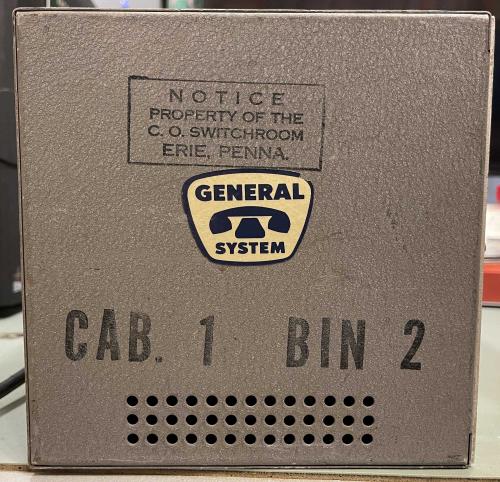
Top of the device is a little dusty, so it appears that it was well cared for in it’s life and not just shoved in a barn somewhere.
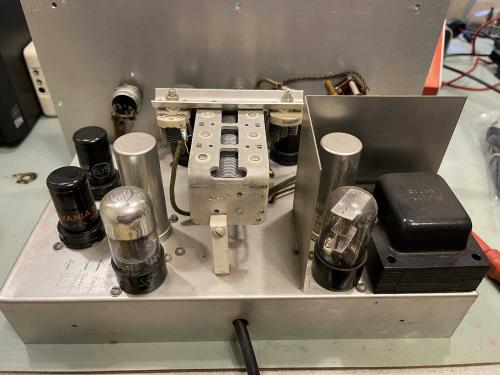
Similarly, the bottom seems to be in good shape.

It almost looks like it was factory built,
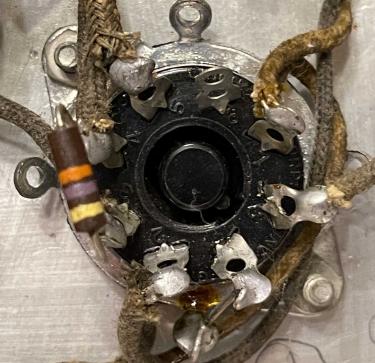
But there are tell-tale signs it was probably put together by someone at the phone company. There is pencil labelling all over the chassis where someone was building it and making notes while they did. That’s always neat to find and gives you a connection to the person that built the device.
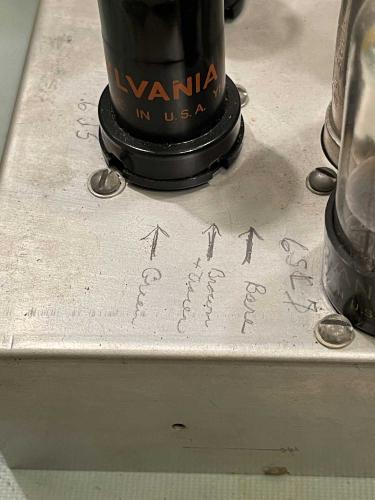
The case itself is in pretty good shape, just some surface rust where the paint was thin or damaged from use over time.

Small banana slicers are used to trim the output.
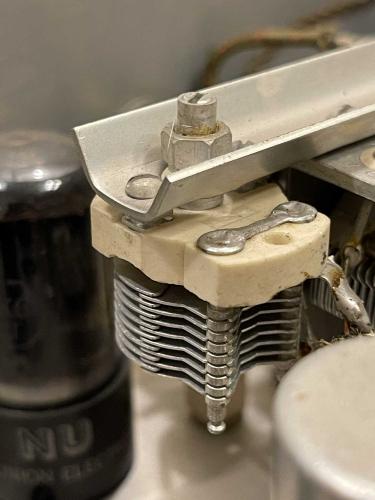
One of the terminals on the front was gone, but since those come apart easily, that’s to be expected. If I wanted to put this back into service, that would be easily fixed.
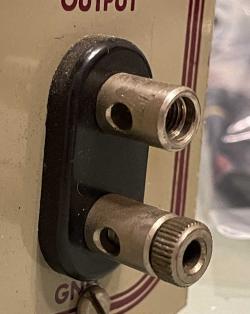
Here’s something that leads me to believe this was probably being used for test tone generation. Here’s the amplitude control. Note the two holes on either side of the pointer - this looks like it was strapped down at some point to give a known output level. The amplitude couldn’t be changed if the control couldn’t be adjusted.
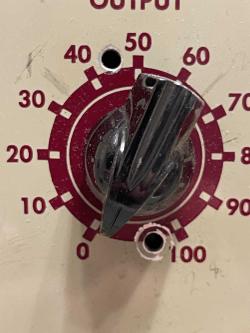
The visual inspection of the device didn’t reveal anything that I felt was concerning enough, and some quick checks of capacitors and other potential failure points seemed to indicate there wasn’t any immediate issues. Time to plug it in!
All of the tubes lit up, so on to checking the output. I let it warm up for a bit.
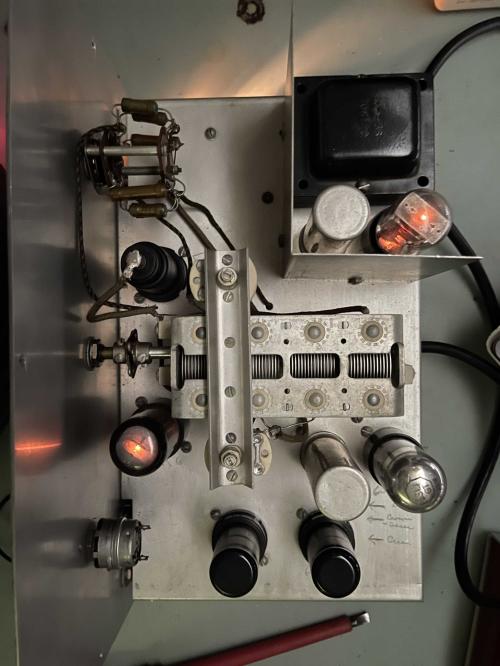
I randomly picked 300Hz as my test point, and set the dial as close as possible. The scope revealed that the device was both off in frequency vs. the dial, and had some problems with waveshape. While I didn’t do any troubleshooting at this point, I suspect that there are some leaky parts simply due to the age of the device.

I ran up the scale with the frequency multiplier control, and it seemed to be pretty stable, generating the multiple of the selected frequency. I chose 3KHz as my next test point and adjusted the output to as close as possible to 3K.
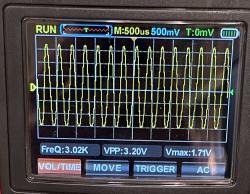
The dial was off a ways. I’m guessing the trimmer capacitors will take care of this, I just need to sit down and read the manual.
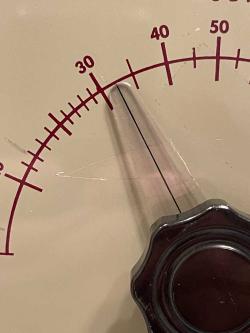
Without changing anything, I selected the squarewave output. It looks good, but drops off considerably vs. the sinewave output.
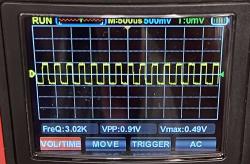
I’m not sure if this is the intended behavior, so I will again refer to the manual that I have not yet read.
Overall, this is kind of a neat piece of equipment. While it’s functionality could be exceeded with a piece of more modern equipment, sometimes it’s nice to have something that won’t be damaged (much) by accidentally having B+ on an input. If time allows, I may try and get this device up and running. It will probably require some new parts, as all of the old ones have drifted with age.
That will be a project for another day.
I’ve started working with this device: https://wereboar.com … part-1-observations/
This came from the Breezeshooters Hamfest in 2023: https://wereboar.com … uff-from-butler-but/
